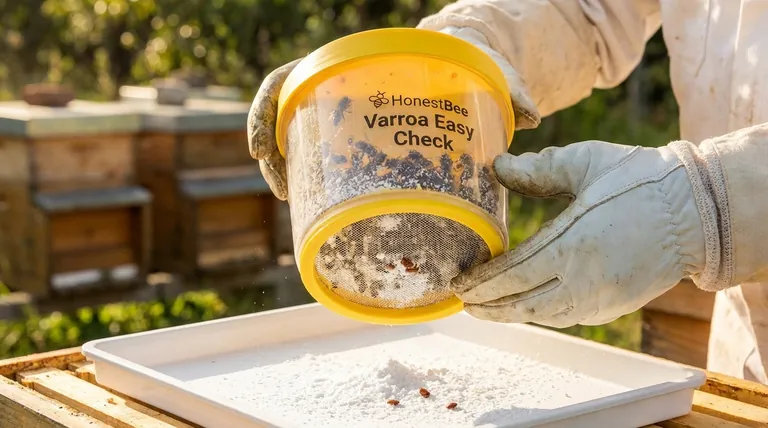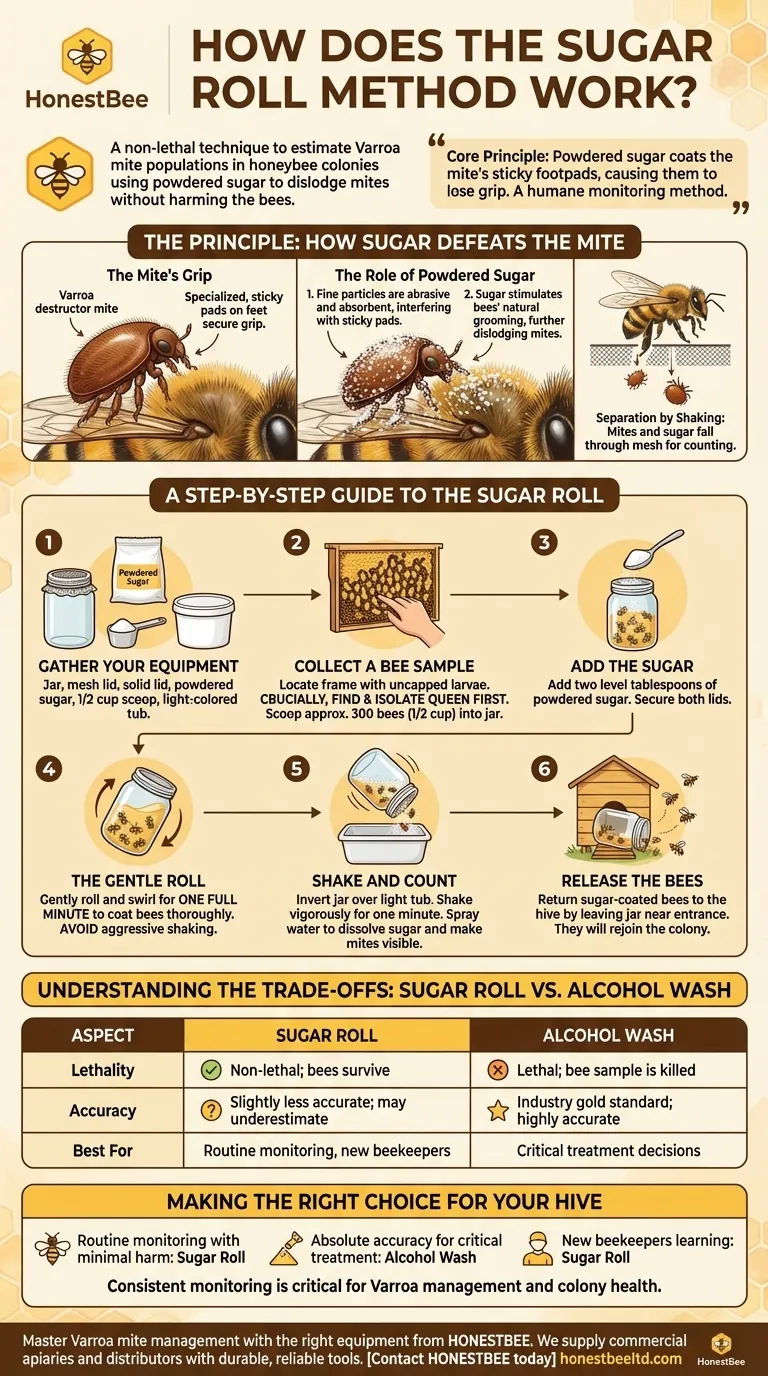The sugar roll method is a non-lethal technique used by beekeepers to estimate the Varroa mite population within a honeybee colony. It works by using powdered sugar to dislodge mites from a sample of bees, allowing them to be separated and counted without killing the bees involved.
The core principle is simple: powdered sugar coats the sticky footpads of Varroa mites, causing them to lose their grip on their honeybee hosts. This provides a humane way to monitor infestation levels, though it is recognized as being slightly less accurate than lethal methods like an alcohol wash.

The Principle: How Sugar Defeats the Mite
Understanding why the sugar roll works requires knowing a bit about the Varroa mite's anatomy and the bees' natural behavior. The method leverages both to achieve its goal.
The Mite's Grip
Varroa destructor mites cling to bees using specialized, sticky pads on their feet. This secure grip allows them to remain attached as the bee moves around the hive and forages.
The Role of Powdered Sugar
The fine particles of powdered sugar serve two functions. First, they are abrasive and absorbent enough to interfere with the mite's sticky footpads, making it difficult for them to hold on.
Second, the sugar coating stimulates the bees' natural grooming instincts. As the bees frantically try to clean themselves and each other, their movements help to further dislodge the already-loosened mites.
Separation by Shaking
Once the mites have lost their grip, a gentle shake is all that is needed. The mites, along with the excess sugar, fall away from the bees and through a mesh screen, where they can be collected for counting.
A Step-by-Step Guide to the Sugar Roll
Performing a sugar roll correctly is crucial for getting a useful mite count.
Step 1: Gather Your Equipment
You will need a specific testing kit or a homemade version, which includes a jar, a lid with an 8-mesh hardware cloth screen, and a solid outer lid. You will also need powdered sugar, a 1/2 cup measuring scoop, and a light-colored tub or tray to collect the sample.
Step 2: Collect a Bee Sample
Locate a frame in the brood box that contains uncapped larvae, as this is where mite-carrying nurse bees are concentrated. Crucially, find and isolate the queen before proceeding.
Scoop approximately 300 bees (a level 1/2 cup) off the frame and into your jar. This number provides a statistically significant sample for calculating your hive's mite load.
Step 3: Add the Sugar
Add two level tablespoons of powdered sugar into the jar with the bees. Secure the mesh lid and then the solid lid.
Step 4: The Gentle Roll
Gently roll and swirl the jar for one full minute. The goal is to coat every bee thoroughly without causing them injury. Avoid shaking the jar aggressively.
Step 5: Shake and Count
After rolling, remove the solid outer lid. Invert the jar over your light-colored tub and shake vigorously for one minute. The sugar and the dislodged mites will fall through the mesh screen onto the tray.
To make the small, brown mites easier to see, you can spray a small amount of water onto the powdered sugar, dissolving it and leaving the mites clearly visible for counting.
Step 6: Release the Bees
The sugar-coated bees can be returned to the hive. Simply leave the jar on its side near the entrance, and they will rejoin the colony.
Understanding the Trade-offs: Sugar Roll vs. Alcohol Wash
The sugar roll is an excellent tool, but it's important to understand its place relative to the industry's gold standard, the alcohol wash.
The Core Difference: Lethality
The most significant advantage of the sugar roll is that the bee sample survives the test. An alcohol wash, which involves submerging the bees in isopropyl alcohol, kills the entire 300-bee sample.
The Question of Accuracy
The alcohol wash is considered more accurate because the alcohol dissolves the bees' cuticle and breaks the mites' grip more effectively, resulting in a near-total mite count from the sample.
The sugar roll is consistently found to be slightly less effective, sometimes underestimating the true mite count. However, for the purpose of routine monitoring, it is generally considered accurate enough to inform treatment decisions.
Making the Right Choice for Your Hive
Choosing the right monitoring method depends entirely on your management philosophy and immediate goals.
- If your primary focus is routine monitoring with minimal harm: The sugar roll is your ideal method for regular checks on mite levels throughout the season.
- If your primary focus is absolute accuracy for a critical treatment decision: The alcohol wash provides the most reliable data to determine if you have crossed a treatment threshold.
- If you are a new beekeeper learning to monitor mites: The sugar roll is an excellent, forgiving method to build your skills and confidence in hive management.
Consistent monitoring is the most critical component of successfully managing Varroa mites and ensuring the long-term health of your colonies.
Summary Table:
| Aspect | Sugar Roll Method | Alcohol Wash Method |
|---|---|---|
| Lethality | Non-lethal; bees survive | Lethal; bee sample is killed |
| Accuracy | Slightly less accurate; may underestimate | Industry gold standard; highly accurate |
| Best For | Routine monitoring, new beekeepers | Critical treatment decisions |
Master Varroa mite management with the right equipment from HONESTBEE. We supply commercial apiaries and distributors with the durable, reliable tools needed for effective monitoring. From testing jars to protective gear, our wholesale-focused operations ensure you get the quality supplies your business depends on.
Contact HONESTBEE today to discuss your beekeeping equipment needs and keep your colonies thriving.
Visual Guide

Related Products
- Varroa Easy Check Mite Tester Kit Counter Alcohol Wash Jar
- Nicot Queen Rearing Kit for Beekeeping and Grafting in Nicot System
- Professional Plastic Queen Excluder for Modern Beekeeping
- Jenter Queen Rearing Kit Complete Set for Bee Breeding
- Langstroth Screen Bottom Board for Beekeeping Wholesale
People Also Ask
- How often should varroa mite checks be performed using the alcohol wash method? Optimize Your Apiary's Health
- Why is an alcohol wash preferred over powdered sugar rolls? For Accurate Varroa Mite Management
- What is the most reliable method for assessing Varroa mite infestations? Master Proactive Hive Management
- What is the Varroa EasyCheck used for? Accurate Mite Monitoring for Healthy Hives
- How does the Varroa EasyCheck determine mite counts? Achieve Accurate Hive Health Monitoring



















